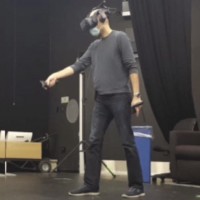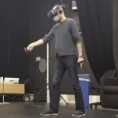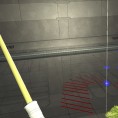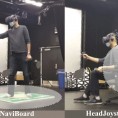
Can more embodied and leaning-based interfaces help support concurrent locomotion and interaction in VR when physical walking isn’t feasible?
Physical walking is often considered the gold standard for VR travel whenever feasible. However, especially for larger-scale virtual travel the free-space walking areas are typically too small, thus requiring handheld controllers to navigate, which can reduce believability, interfere with simultaneous interaction tasks, and exacerbate adverse effects such as motion sickness and disorientation. To investigate alternative locomotion options, we compared handheld Controller(thumbstick-based) and physical walking versus a seated (HeadJoystick) and standing/stepping (NaviBoard) leaning-based locomotion interfaces, where seated/standing users travel by moving their head toward the target direction. Rotations were always physically performed. To compare these interfaces, we designed a novel simultaneous locomotion and object interaction task, where users needed to keep touching the center of upward moving target balloons with their virtual lightsaber, while simultaneously staying inside a horizontally moving enclosure. Locomotion, interaction, and combined performance was best for walking and worst for controller. Leaning-based interfaces improved user experience and performance compared to Controller, especially when standing/stepping using NaviBoard, but did not reach walking performance. That is, leaning-based interfaces HeadJoystick (sitting) and NaviBoard (standing) that provided additional physical self-motion cues compared to controller improved enjoyment, preference, spatial presence, vection intensity, motion sickness, as well as performance for locomotion, object interaction, and combined locomotion and interaction.
Our “Lightsaber” task is illustrated below for the different locomotion interfaces:
Controller
HeadJoystick
NaviBoard
Walking


